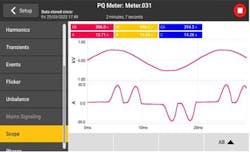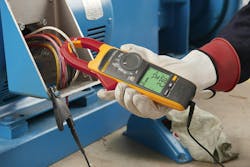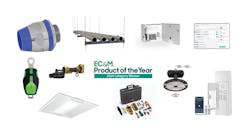Power quality measurements and data tracking are essential in determining the reliability and efficiency of your power system. Power quality is the measure of the consistency of the electrical supply that is delivered to your equipment and devices that rely on it to run smoothly.
Harmonics, in turn, are a component you want to watch out for while taking power quality measurements. They can have a significant impact on the performance of your system. Harmonics are essentially unwanted electrical frequencies that can distort the waveform of an electrical signal. They are caused by non-linear loads, like variable-frequency drives, computers, or electrical equipment that use switching power supplies. These non-linear loads can produce harmonics that distort the waveform of the electrical signal, which can lead to a wide range of problems within your system. See the Figure below.
Impact of harmonics on your system
One of the most significant issues you may see if harmonics are present is increased heat in electrical equipment. Overheating on transformers, motors, and other electrical devices can lead to reduced efficiency and premature failure. Overheating can also cause insulation breakdown, which can result in short circuits, fires, and other safety hazards.
If you’re seeing a reduced power factor or lower efficiency of the power system, it could be another sign you’re dealing with harmonics. Power factor is essential to ensure that the electrical supply coming into your facility is used efficiently. Harmonics causing that reduction can have a cascading effect leading to increased energy consumption, higher utility bills, and reduced electrical system capacity.
The presence of harmonics can also be seen in smaller ways around your facility. Things like flickering lights or communication system interference. No matter how the issues present themselves, harmonics can have a significant impact on the performance of your power system. It’s best to monitor and mitigate their effects when those issues show up.
Mitigating the effects of harmonics
Start with making sure you have routine preventive maintenance checks of your non-linear loads. That way you can catch and address the problems before they get too large.
Once you have found an issue, you’ll want to start with the issues you’re seeing, properly identifying the root cause of the problem, and isolating the source. Start by measuring with a clamp meter that can indicate power quality issues (Photo 1). A tool like this can help indicate total harmonic distortion (THD) and show all harmonics present. THD for voltage should not exceed 5% to 6%, and THD for current will run considerably higher.
Excessive THD for voltage means any number of problems could be occurring, and you should continue to get to the bottom of them so corrective action can be taken. To further investigate the magnitude and effects of the individual harmonics, you’ll need more detailed information from a more powerful tool, like a power quality analyzer (Photo 2).
A power quality analyzer can record disturbances, like harmonics, in your line power by recording and monitoring the power quality over some time. Your analyzer can pick up all sorts of potential problems like dips and swells, wasted energy and electrical disturbances, or other issues that can cause the malfunction of control circuits.
Harmonics can be a significant problem in a power system, often leading to reduced efficiency, increased energy consumption, and larger safety hazards. It’s important to monitor your power systems to identify the presence of harmonics and mitigate any havoc caused on a system before it creates costly downtime or repair issues. By taking these steps, power system operators can ensure that their systems are reliable, efficient, and safe.







